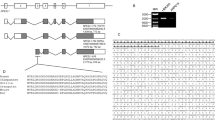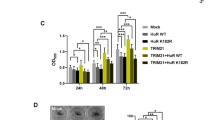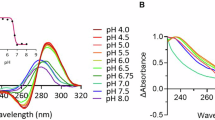Abstract
Nuclear factor erythroid 2-related factor 2 (Nrf2, NM 006164, 605 AA) is essential for the antioxidant responsive element (ARE)-mediated expression of a group of detoxifying antioxidant genes that detoxify carcinogens and protect against oxidative stress. Several proteins have been identified as Nrf2-interacting molecules. In this study, we found that the overexpression of receptor-associated coactivator 3 (RAC3)/AIB-1/steroid receptor coactivator-3, a nuclear coregulator and oncogene frequently amplified in human breast cancers, induced heme oxygenase-1 (HO-1) through Nrf2 transactivation in HeLa cells. Next, we determined the interaction between RAC3 and Nrf2 proteins using a co-immunoprecipitation assay and fluorescence resonance energy transfer analysis. The results showed that RAC3 bound directly to the Nrf2 protein in the nucleus. Subsequently, we identified the interacting domains of Nrf2 and RAC3 using a glutathione S-transferase pull-down assay. The results showed that both the N-terminal RAC3-pasB and C-terminal RAC3-R3B3 domains were tightly bound to the Neh4 and Neh5 transactivation domains. Furthermore, chromatin immunoprecipitation showed that RAC3 bound tightly to the ARE enhancer region of the HO-1 promoter via Nrf2 binding. These data suggest that Nrf2 activation is modulated and directly controlled through interactions with the RAC3 protein in HeLa cells.
This is a preview of subscription content, access via your institution
Access options
Subscribe to this journal
Receive 50 print issues and online access
$259.00 per year
only $5.18 per issue
Buy this article
- Purchase on SpringerLink
- Instant access to full article PDF
Prices may be subject to local taxes which are calculated during checkout








Similar content being viewed by others
Abbreviations
- ACTR:
-
activator of retinoid and thyroid receptors
- AIB-1:
-
amplified in breast cancer-1 protein
- ARE:
-
antioxidant responsive element
- GST:
-
glutathione S-transferase
- HO-1:
-
heme oxygenase-1
- Keap1:
-
Kelch-like ECH-associated protein 1
- NCoA-3:
-
nuclear receptor coactivator-3
- Neh:
-
Nrf2-ECH homology
- Nrf2:
-
nuclear factor erythroid 2-related factor 2
- pCIP:
-
CBP-interacting protein
- RAC3:
-
receptor-associated coactivator 3
- SRC-3:
-
steroid receptor coactivator protein-3
- TAD:
-
transactivation domain
- TRAM-1:
-
thyroid hormone receptor activator molecule-1
References
Alam J, Stewart D, Touchard C, Boinapally S, Choi AM, Cook JL . (1999). Nrf2, a Cap'n'Collar transcription factor, regulates induction of the heme oxygenase-1 gene. J Biol Chem 274: 26071–26078.
Anzick SL, Kononen J, Walker RL, Azorsa DO, Tanner MM, Guan XY et al. (1997). AIB1, a steroid receptor coactivator amplified in breast and ovarian cancer. Science 277: 965–968.
Arimura A, vn Peer M, Schroder AJ, Rothman PB . (2004). The transcriptional co-activator p/CIP (NCoA-3) is up-regulated by STAT6 and serves as a positive regulator of transcriptional activation by STAT6. J Biol Chem 279: 31105–31112.
Blank V . (2008). Small Maf proteins in mammalian gene control: mere dimerization partners or dynamic transcriptional regulators? J Mol Biol 376: 913–925.
Chan K, Han XD, Kan YW . (2001). An important function of Nrf2 in combating oxidative stress: detoxification of acetaminophen. Proc Natl Acad Sci USA 98: 4611–4616.
Chan K, Kan YW . (1999). Nrf2 is essential for protection against acute pulmonary injury in mice. Proc Natl Acad Sci USA 96: 12731–12736.
Chen D, Ma H, Hong H, Koh SS, Huang SM, Schurter BT et al. (1999). Regulation of transcription by a protein methyltransferase. Science 284: 2174–2177.
Chen H, Lin RJ, Schiltz RL, Chakravarti D, Nash A, Nagy L et al. (1997). Nuclear receptor coactivator ACTR is a novel histone acetyltransferase and forms a multimeric activation complex with P/CAF and CBP/p300. Cell 90: 569–580.
Enomoto A, Itoh K, Nagayoshi E, Haruta J, Kimura T, O'Connor T et al. (2001). High sensitivity of Nrf2 knockout mice to acetaminophen hepatotoxicity associated with decreased expression of ARE-regulated drug metabolizing enzymes and antioxidant genes. Toxicol Sci 59: 169–177.
Gnanapragasam VJ, Leung HY, Pulimood AS, Neal DE, Robson CN . (2001). Expression of RAC 3, a steroid hormone receptor co-activator in prostate cancer. Br J Cancer 85: 1928–1936.
Han SJ, DeMayo FJ, Xu J, Tsai SY, Tsai MJ, O'Malley BW . (2006). Steroid receptor coactivator (SRC)-1 and SRC-3 differentially modulate tissue-specific activation functions of the progesterone receptor. Mol Endocrinol 20: 45–55.
Hayashi A, Suzuki H, Itoh K, Yamamoto M, Sugiyama Y . (2003). Transcription factor Nrf2 is required for the constitutive and inducible expression of multidrug resistance-associated protein 1 in mouse embryo fibroblasts. Biochem Biophys Res Commun 310: 824–829.
Heery DM, Kalkhoven E, Hoare S, Parker MG . (1997). A signature motif in transcriptional co-activators mediates binding to nuclear receptors. Nature 387: 733–736.
Henke RT, Haddad BR, Kim SE, Rone JD, Mani A, Jessup JM et al. (2004). Overexpression of the nuclear receptor coactivator AIB1 (SRC-3) during progression of pancreatic adenocarcinoma. Clin Cancer Res 10: 6134–6142.
Huang HC, Nguyen T, Pickett CB . (2002). Phosphorylation of Nrf2 at Ser-40 by protein kinase C regulates antioxidant response element-mediated transcription. J Biol Chem 277: 42769–42774.
Katoh Y, Itoh K, Yoshida E, Miyagishi M, Fukamizu A, Yamamoto M . (2001). Two domains of Nrf2 cooperatively bind CBP, a CREB binding protein, and synergistically activate transcription. Genes Cells 6: 857–868.
Kobayashi M, Itoh K, Suzuki T, Osanai H, Nishikawa K, Katoh Y et al. (2002). Identification of the interactive interface and phylogenic conservation of the Nrf2-Keap1 system. Genes Cells 7: 807–820.
Kobayashi M, Yamamoto M . (2005). Molecular mechanisms activating the Nrf2-Keap1 pathway of antioxidant gene regulation. Antioxid Redox Signal 7: 385–394.
Koh SS, Chen D, Lee YH, Stallcup MR . (2001). Synergistic enhancement of nuclear receptor function by p160 coactivators and two coactivators with protein methyltransferase activities. J Biol Chem 276: 1089–1098.
Kong AN, Owuor E, Yu R, Hebbar V, Chen C, Hu R et al. (2001). Induction of xenobiotic enzymes by the MAP kinase pathway and the antioxidant or electrophile response element (ARE/EpRE). Drug Metab Rev 33: 255–271.
Kuang SQ, Liao L, Zhang H, Lee AV, O'Malley BW, Xu J . (2004). AIB1/SRC-3 deficiency affects insulin-like growth factor I signaling pathway and suppresses v-Ha-ras-induced breast cancer initiation and progression in mice. Cancer Res 64: 1875–1885.
Lee JM, Calkins MJ, Chan K, Kan YW, Johnson JA . (2003). Identification of the NF-E2-related factor-2-dependent genes conferring protection against oxidative stress in primary cortical astrocytes using oligonucleotide microarray analysis. J Biol Chem 278: 12029–12038.
Lee JM, Chan K, Kan YW, Johnson JA . (2004). Targeted disruption of Nrf2 causes regenerative immune-mediated hemolytic anemia. Proc Natl Acad Sci USA 101: 9751–9756.
Lee SK, Kim HJ, Na SY, Kim TS, Choi HS, Im SY et al. (1998). Steroid receptor coactivator-1 coactivates activating protein-1-mediated transactivations through interaction with the c-Jun and c-Fos subunits. J Biol Chem 273: 16651–16654.
Leo C, Chen JD . (2000). The SRC family of nuclear receptor coactivators. Gene 245: 1–11.
Li C, Wu RC, Amazit L, Tsai SY, Tsai MJ, O'Malley BW . (2007). Specific amino acid residues in the basic helix-loop-helix domain of SRC-3 are essential for its nuclear localization and proteasome-dependent turnover. Mol Cell Biol 27: 1296–1308.
Li Y, Jaiswal AK . (1993). Regulation of human NAD(P)H:quinone oxidoreductase gene. Role of AP1 binding site contained within human antioxidant response element. J Biol Chem 268: 21454.
Lin W, Shen G, Yuan X, Jain MR, Yu S, Zhang A et al. (2006). Regulation of Nrf2 transactivation domain activity by p160 RAC3/SRC3 and other nuclear co-regulators. J Biochem Mol Biol 39: 304–310.
McKenna NJ, Lanz RB, O'Malley BW . (1999). Nuclear receptor coregulators: cellular and molecular biology. Endocr Rev 20: 321–344.
McKenna NJ, O'Malley BW . (2002). Combinatorial control of gene expression by nuclear receptors and coregulators. Cell 108: 465–474.
McMahon M, Itoh K, Yamamoto M, Chanas SA, Henderson CJ, McLellan LI et al. (2001). The Cap'n'Collar basic leucine zipper transcription factor Nrf2 (NF-E2 p45-related factor 2) controls both constitutive and inducible expression of intestinal detoxification and glutathione biosynthetic enzymes. Cancer Res 61: 3299–3307.
Morse MA, Stoner GD . (1993). Cancer chemoprevention: principles and prospects. Carcinogenesis 14: 1737–1746.
Motohashi H, Yamamoto M . (2004). Nrf2-Keap1 defines a physiologically important stress response mechanism. Trends Mol Med 10: 549–557.
Nakaso K, Yano H, Fukuhara Y, Takeshima T, Wada-Isoe K, Nakashima K . (2003). PI3K is a key molecule in the Nrf2-mediated regulation of antioxidative proteins by hemin in human neuroblastoma cells. FEBS Lett 546: 181–184.
Nguyen T, Sherratt PJ, Huang HC, Yang CS, Pickett CB . (2003). Increased protein stability as a mechanism that enhances Nrf2-mediated transcriptional activation of the antioxidant response element. Degradation of Nrf2 by the 26 S proteasome. J Biol Chem 278: 4536–4541.
Rushmore TH, Pickett CB . (1990). Transcriptional regulation of the rat glutathione S-transferase Ya subunit gene. Characterization of a xenobiotic-responsive element controlling inducible expression by phenolic antioxidants. J Biol Chem 265: 14648–14653.
Sakakura C, Hagiwara A, Yasuoka R, Fujita Y, Nakanishi M, Masuda K et al. (2000). Amplification and over-expression of the AIB1 nuclear receptor co-activator gene in primary gastric cancers. Int J Cancer 89: 217–223.
Shen G, Hebbar V, Nair S, Xu C, Li W, Lin W et al. (2004). Regulation of Nrf2 transactivation domain activity. The differential effects of mitogen-activated protein kinase cascades and synergistic stimulatory effect of Raf and CREB-binding protein. J Biol Chem 279: 23052–23060.
Takeshita A, Cardona GR, Koibuchi N, Suen CS, Chin WW . (1997). TRAM-1, A novel 160-kDa thyroid hormone receptor activator molecule, exhibits distinct properties from steroid receptor coactivator-1. J Biol Chem 272: 27629–27634.
Torres-Arzayus MI, Font de Mora J, Yuan J, Vazquez F, Bronson R, Rue M et al. (2004). High tumor incidence and activation of the PI3K/AKT pathway in transgenic mice define AIB1 as an oncogene. Cancer Cell 6: 263–274.
Trinkle-Mulcahy L, Sleeman JE, Lamond AI . (2001). Dynamic targeting of protein phosphatase 1 within the nuclei of living mammalian cells. J Cell Sci 114: 4219–4228.
Vollrath V, Wielandt AM, Iruretagoyena M, Chianale J . (2006). Role of Nrf2 in the regulation of the Mrp2 (ABCC2) gene. Biochem J 395: 599–609.
Wang Y, Wu MC, Sham JS, Zhang W, Wu WQ, Guan XY . (2002). Prognostic significance of c-myc and AIB1 amplification in hepatocellular carcinoma. A broad survey using high-throughput tissue microarray. Cancer 95: 2346–2352.
Wang Z, Rose DW, Hermanson O, Liu F, Herman T, Wu W et al. (2000). Regulation of somatic growth by the p160 coactivator p/CIP. Proc Natl Acad Sci USA 97: 13549–13554.
Werbajh S, Nojek I, Lanz R, Costas MA . (2000). RAC-3 is a NF-kappa B coactivator. FEBS Lett 485: 195–199.
Wu X, Li H, Chen JD . (2001). The human homologue of the yeast DNA repair and TFIIH regulator MMS19 is an AF-1-specific coactivator of estrogen receptor. J Biol Chem 276: 23962–23968.
Xie D, Sham JS, Zeng WF, Lin HL, Bi J, Che LH et al. (2005). Correlation of AIB1 overexpression with advanced clinical stage of human colorectal carcinoma. Hum Pathol 36: 777–783.
Xu FP, Xie D, Wen JM, Wu HX, Liu YD, Bi J et al. (2007). SRC-3/AIB1 protein and gene amplification levels in human esophageal squamous cell carcinomas. Cancer Lett 245: 69–74.
Xu J, Liao L, Ning G, Yoshida-Komiya H, Deng C, O'Malley BW . (2000). The steroid receptor coactivator SRC-3 (p/CIP/RAC3/AIB1/ACTR/TRAM-1) is required for normal growth, puberty, female reproductive function, and mammary gland development. Proc Natl Acad Sci USA 97: 6379–6384.
Yan J, Yu CT, Ozen M, Ittmann M, Tsai SY, Tsai MJ . (2006). Steroid receptor coactivator-3 and activator protein-1 coordinately regulate the transcription of components of the insulin-like growth factor/AKT signaling pathway. Cancer Res 66: 11039–11046.
Yao TP, Ku G, Zhou N, Scully R, Livingston DM . (1996). The nuclear hormone receptor coactivator SRC-1 is a specific target of p300. Proc Natl Acad Sci USA 93: 10626–10631.
Ying H, Furuya F, Willingham MC, Xu J, O'Malley BW, Cheng SY . (2005). Dual functions of the steroid hormone receptor coactivator 3 in modulating resistance to thyroid hormone. Mol Cell Biol 25: 7687–7695.
Zhang Y, Talalay P, Cho CG, Posner GH . (1992). A major inducer of anticarcinogenic protective enzymes from broccoli: isolation and elucidation of structure. Proc Natl Acad Sci USA 89: 2399–2403.
Zhou G, Hashimoto Y, Kwak I, Tsai SY, Tsai MJ . (2003). Role of the steroid receptor coactivator SRC-3 in cell growth. Mol Cell Biol 23: 7742–7755.
Zhu M, Fahl WE . (2001). Functional characterization of transcription regulators that interact with the electrophile response element. Biochem Biophys Res Commun 289: 212–219.
Acknowledgements
We thank Dr Jianjie Ma (Department of Physiology and Biophysics, University of Medicine and Dentistry of New Jersey, Newark, New Jersey, USA) for help with confocal microscopy. This study was supported by NIH Grant R01 NIH R01-CA-94828.
Author information
Authors and Affiliations
Corresponding author
Ethics declarations
Competing interests
The authors declare no conflict of interest.
Rights and permissions
About this article
Cite this article
Kim, JH., Yu, S., Chen, J. et al. The nuclear cofactor RAC3/AIB1/SRC-3 enhances Nrf2 signaling by interacting with transactivation domains. Oncogene 32, 514–527 (2013). https://doi.org/10.1038/onc.2012.59
Received:
Revised:
Accepted:
Published:
Issue Date:
DOI: https://doi.org/10.1038/onc.2012.59



